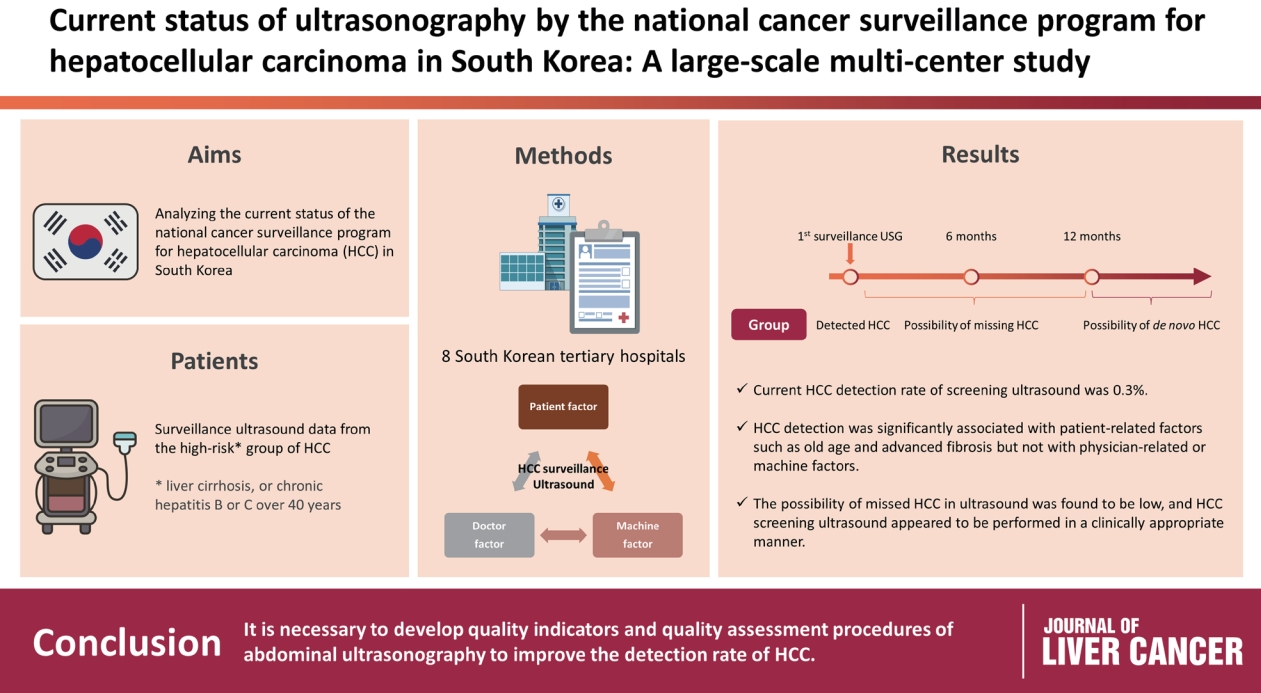- Current status of ultrasonography in national cancer surveillance program for hepatocellular carcinoma in South Korea: a large-scale multicenter study
-
Sun Hong Yoo, Soon Sun Kim, Sang Gyune Kim, Jung Hyun Kwon, Han-Ah Lee, Yeon Seok Seo, Young Kul Jung, Hyung Joon Yim, Do Seon Song, Seong Hee Kang, Moon Young Kim, Young-Hwan Ahn, Jieun Han, Young Seok Kim, Young Chang, Soung Won Jeong, Jae Young Jang, Jeong-Ju Yoo
-
J Liver Cancer. 2023;23(1):189-201. Published online March 24, 2023
-
DOI: https://doi.org/10.17998/jlc.2023.03.11
-
-
1,605
Views
-
65
Downloads
-
2
Citations
-
 Abstract Abstract
 PDF PDF Supplementary Material Supplementary Material
- Background/Aim
Abdominal ultrasonography (USG) is recommended as a surveillance test for high-risk groups for hepatocellular carcinoma (HCC). This study aimed to analyze the current status of the national cancer surveillance program for HCC in South Korea and investigate the effects of patient-, physician-, and machine-related factors on HCC detection sensitivity.
Methods
This multicenter retrospective cohort study collected surveillance USG data from the high-risk group for HCC (liver cirrhosis or chronic hepatitis B or C >40 years of age) at eight South Korean tertiary hospitals in 2017.
Results
In 2017, 45 experienced hepatologists or radiologists performed 8,512 USG examinations. The physicians had a mean 15.0±8.3 years of experience; more hepatologists (61.4%) than radiologists (38.6%) participated. Each USG scan took a mean 12.2±3.4 minutes. The HCC detection rate by surveillance USG was 0.3% (n=23). Over 27 months of follow-up, an additional 135 patients (0.7%) developed new HCC. The patients were classified into three groups based on timing of HCC diagnosis since the 1st surveillance USG, and no significant intergroup difference in HCC characteristics was noted. HCC detection was significantly associated with patient-related factors, such as old age and advanced fibrosis, but not with physician- or machine-related factors.
Conclusions
This is the first study of the current status of USG as a surveillance method for HCC at tertiary hospitals in South Korea. It is necessary to develop quality indicators and quality assessment procedures for USG to improve the detection rate of HCC.
-
Citations
Citations to this article as recorded by  - The Epidemiology of Hepatitis B Virus Infection in Korea: 15-Year Analysis
Log Young Kim, Jeong-Ju Yoo, Young Chang, Hoongil Jo, Young Youn Cho, Sangheun Lee, Dong Hyeon Lee, Jae Young Jang
Journal of Korean Medical Science.2024;[Epub] CrossRef - Long-Term HBsAg Titer Kinetics with Entecavir/Tenofovir: Implications for Predicting Functional Cure and Low Levels
Soon Kyu Lee, Soon Woo Nam, Jeong Won Jang, Jung Hyun Kwon
Diagnostics.2024; 14(5): 495. CrossRef
- Complications Associated with Transcatheter Arterial Chemoembolization in Patients with Hepatocellular Carcinoma
-
Sun Hong Yoo, Si Hyun Bae
-
Journal of the Korean Liver Cancer Study Group. 2011;11(2):144-148. Published online September 30, 2011
-
-
-
 Abstract Abstract
 PDF PDF
- Transcatheter arterial chemoembolization (TACE) is one of the most effective treatments for patients with inoperable
hepatocellular carcinoma (HCC). However, variable complications can occur after TACE. Complications resulting from TACE
contain postembolization syndrome, liver abscess, bile duct injury, ruptured HCC, acute hepatic failure, variceal bleeding, acute
kidney injury, pulmonary lipiodol embolization, femoral artery pseudoaneurysm, femoral arteriovenous fistula, abdominal aortic
dissection, spinal cord injury, and others. Complications after TACE are occasionally fatal. Therefore, it is important that we are
well acquainted ourselves with these complications, and need care promptly the patient who develop symptoms of complication.
- Conus Medullaris Syndrome after Transcatheter Arterial Chemoembolization in Patient with Hepatocellular Carcinoma
-
Sun Hong Yoo, Si Hyun Bae, Pil Soo Sung, Hee Yeon Kim, Do Seon Song, Myeong Jun Song, Jong Young Choi, Seung Kew Yoon, Ho Jong Chun
-
Journal of the Korean Liver Cancer Study Group. 2011;11(2):185-189. Published online September 30, 2011
-
-
-
 Abstract Abstract
 PDF PDF
- Hepatocellular carcinoma (HCC) is the fourth most common cancer in Korea and a common cause of cancer death.
Transcatheter arterial chemoembolization (TACE) is used as palliative therapy for patients with inoperable HCC. TACE is an
effective treatments for inoperable HCC, but variable complications due to using embolic agents can occur after TACE.
Complications due to embolic agents include pulmonary lipiodol embolism, splenic infarction, cerebral lipiodol infarction, and
spinal cord injury. This is a rare case of spinal cord injury after a sixth TACE via right T9 intercostal artery.
|







